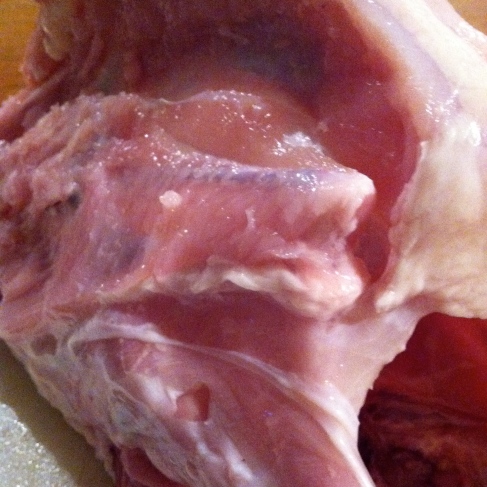For those of you that inquired about my turkeys, the farm is called Arch River Farm and it is in Milbrook, NY. Their website is:
They raised about 100 birds this year as well as pigs, cows, and some chickens. During growing season, they come to the White Plains Farmer’s Market and Milbrook Farmer’s Market. Their animals are pasture fed and raised “in comfort” which affords the best possible products.
Here is a brief bit about the difference between heritage birds and commercially raised turkeys. I am calling them butterballs but generally any supermarket brand will be of the same variety: the Broad Breasted White. This breed is owned by 3 multi-national corporations and has caused near extinction to every other breed of turkeys. Thanks to conservationists and local family farms, the heritage breeds are still around but they produce roughly 25,000/year as opposed to the broad breasted white’s 200,000,000!
The difference between a butterball and a free range turkey is amazing. I was given 2 butterballs this year to cook for The Lord’s Pantry. The Lord’s Pantry is an organization founded by my late Grandmother Joan McGovern to help feed homebound AIDS patients and their families. If you would like to volunteer or donate, this is their website:
https://www.facebook.com/thelordspantry
Back to turkeys:
Above is the butchered carcus of the butterball.
Compared to the butchered free range turkey.
The color of the meat was completely different. These pictures don’t do it justice. The butterball had an ENORMOUS light pink breast compared to a tight and compact Purple breast from the free range turkey. You should also note the relative size of the breast to the rest of the carcus. Modern turkeys are bred to hold 70% of their body mass in their breast (OMG imagine that!!!!)
Butterball (and the likes) have bred their turkeys to be top-heavy because the market demanded more white meat. Interestingly enough, 100% of commercially raised turkeys in America are artificially inseminated. This is because the male turkeys (which have been selectively bred for their big breasts) cannot physically mate with the females due to the overwhelming size of their breast. These selectively bred turkeys can barely walk straight. So basically, without human beings aiding in the reproduction process, the modern butterball would cease to exist. These turkeys also grow very quickly (by design) and typically cannot survive past 13-14 weeks! The breeding stock for the modern mass market turkey is owned by 3 corporations. As these turkeys were bred and bred and bred (and bought and bought and bought), the other turkey breeds started dying out. Such a messed up and sad story.
Heritage birds, which are the type you might find being sold at a Farmer’s Market or at an organic grocery store, are on the rise. They are called heritage because they are a breed from our past. While there isn’t a specific classification for heritage bird (such as the highly regulated term “organic”) they have to maintain 3 characteristics to be true “heritage birds:”
1. The ability to reproduce naturally (seriously…this should probably be required of ANY food that we eat, no???)
2. A slow growth period (28 weeks compared to commercial 13-14 weeks)
3. A long lifespan (Sadly, genetically engineered turkeys usually cannot survive past 13-14 weeks on their own and are usually slaughtered around then anyway.)
The Heritage birds are small in comparison and their breast is much smaller than that of their genetically modified cousins. Because these turkeys are usually free range, they actually USE their muscles to move around, mate, graze, play, etc so the muscle is more developed and therefore results in a deep red/purple color. They also take longer to grow, allowing full skeletal and organ development. The ratio of dark meat to light meat is about 50/50 in heritage birds as opposed to the 30/70 found in mass market turkeys.
Because heritage birds are slaughtered later in life (nearly double the growth period of butterballs) they have time to accrue fat layers and therefore more flavor potential. My turkey was absolutely delicious and everyone (all 30 guests!) asked about where my turkey was from, how I cooked it, etc. I cooked it to let the flavors speak for themselves and my turkey was the centerpiece, not just a gravy delivery vehicle ;).
There is also evidence of health benefits (i mean, DUH) in the heritage birds as opposed to the genetically engineered butterballs. Because the heritage birds are pasture raised, they feed on insects and grass, their meat is significantly higher in Omega-3 Fatty acids which can help prevent heart disease.
Generally local turkey farmers raising heritage breeds charge around $5-6 a pound. This price is a product of long growth periods (lots of food/land) and the cost of the original turkey, as well as a host of other costs that local farmers endure while industrial farmers enjoy a short growth period rife with government subsidies. I don’t want to get too political on this blog, but PLEASE pay attention to where you are spending your money…it matters. We need to support our local farms and help keep heritage breeds and REAL food around. It is so important to the health of our community, our own health, and the health of our children.
Happy Thanksgiving and Happy Holidays to everyone, xo, SW and Sweet P














Reblogged this on Sweet P's Kitchen- #beautifulfood and commented:
Don’t forget small business Saturday today people!